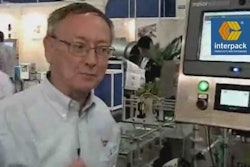
In this, the third in a series of posts based upon the Packaging Automation Forum held recently in Chicago, I share and comment upon the remarks of presenters who drilled down into the details of their internal programs for driving productivity.
Jim Whalen, Director of Operations Services for Rich Products Corporation described the simple principles and hard work involved in Rich's Manufacturing Line Optimization (MLO) program. This program has as its goals to develop processes and systems to track and optimize productivity and utilization, to identify and develop the key skills required of associates to support the program, and to develop standards, metrics and targets along with communications to develop pay for performance systems.
Building upon lean principles, management took the approach of using OEE metrics as the basis of assessing performance. The company realized there was extensive opportunity to drive cost savings across 110 production lines by improving the quality, consistency and frequency of data collection and providing tools and processes that would empower their engaged associates and leaders to drive continuous improvement.
With only 16% of firms describing their lean / continuous improvement programs as successful and only 9% claiming to sustain savings over 3 years, Rich took a hard look at the 6 greatest challenges to success. These include: 1) Resource constraints; 2) front line disengagement; 3) ineffective training; 4) lack of cross-functional support; 5) poor project selection; and 6) loss of organizational focus.
In addressing these challenges, one of the key strategic decisions was to adopt a common platform that would standardize the computer integration strategies across the entire manufacturing network and then evolve collectively, accumulating lots of base hits and not worrying so much about home runs. This strategy, borrowed from Cargill, was followed even if it meant that some plants needed to take a step backward.
Another key area for driving success is change management. Change management stages are defined by the term ADKAR. Best practice includes managing the processes of creating Awareness of the need for change, moving that awareness to Desire, providing Knowledge to create ability, and Reinforcing, auditing and recognizing people to keep the change in place. But the number one success factor for change is executive sponsorship and keeping leadership actively engaged in the change.
By following these steps, the associates at Rich Products were able to apply the tools installed to achieve results such as increasing OEE from 67.8% to 72.5%, improving performance from 83.8% to 89.8% and reducing the average downtime event from 12.9 to 6.7 minutes while improving planning rates which resulted in reducing shifts, increasing capacity and reducing inventory. All this was accomplished by applying simple principles and following up with some hard work.
Tell us about your productivity successes!
Comments
Good article! I always tell companies, if they don't stay-on-top of trying to maintain or exceed the savings we've achieved through quick-changoever, they will only be wasting their money. Changing the culture issues (we've done it this way for 20 years) and making sure that the technology and process are implemented properly are paramount.
Posted by: Leonard Antosiak on August 31, 2011

























